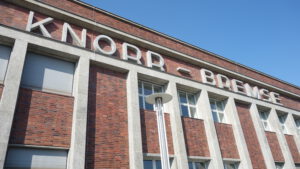Eight fire brigades were alerted when the track tamping machine suddenly caught fire in the early hours of the morning. The Westbahn route was temporarily closed between Melk and Pöchlarn (Melk district). But the fire was quickly brought under control and there were no injuries. The result, however, was delays in rail traffic until the afternoon hours. The track tamping machine was part of the work train of a private track construction company.
According to the preliminary result of the police investigation, hydraulic oil in the amount of ten to 15 liters escaped during the incident. According to this, heat may have developed in the area of the transmission for the hydraulic pressure in the front part of the implement, causing the hydraulic oil to ignite. CARGO-MANAGER wanted to know from Ing. Gerhard Kellner, the managing director of the German railway workshop MaLoWa in Benndorf, how can the hydraulic oil be able to ignite just because of the heat. Does this indicate a design or production error, poor maintenance or operation?
You can’t say that, emphasized the workshop expert. The numerous hydraulic hoses are heated up during work anyway. As long as they are tight and keep the oil away from other machine parts, the risk is low. It is different if individual hoses become porous and thus perhaps also leak at connections. If hot oil gets on hot vehicle components or electrical parts, it can easily cause a fire. But why should a hose become porous, were revision deadlines not met and the hoses not replaced in time?
You can’t say that either, says workshop boss Kellner: “The hoses can definitely be optically in order with a regular overhaul, so that you don’t exchange them because they don’t have to be changed according to the manufacturer’s rules and rail regulations. But then something else happens to them later.” Hoses become porous primarily when exposed to sunlight. Perhaps there was unevenly strong solar radiation? A single leaky hose is enough to start a fire in the worst case. Kellner: “Replacing all the hydraulic hoses in such a large machine can easily cost 40,000 euros and takes several weeks.” Who would go to the trouble of doing this for no apparent reason? One can only hope that the track construction company is well insured…
Hermann Schmidtendorf, Editor-in-Chief









